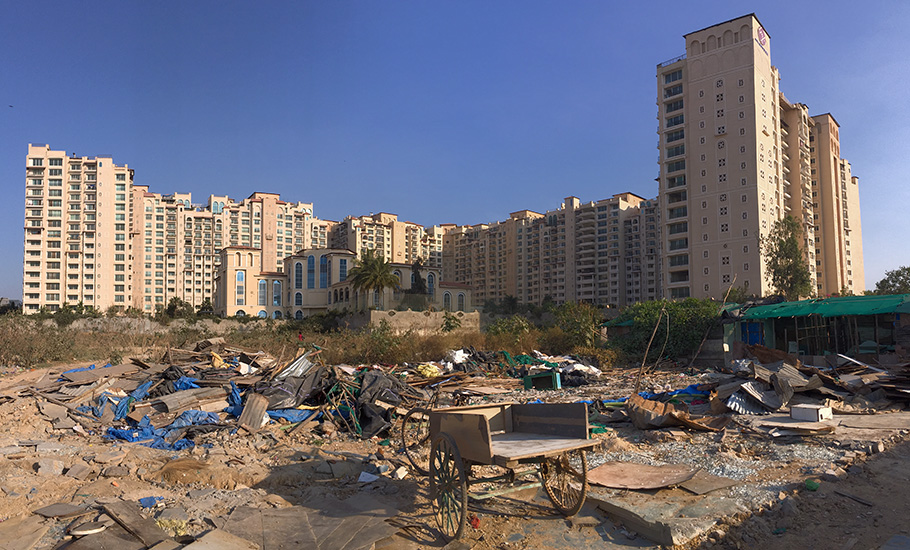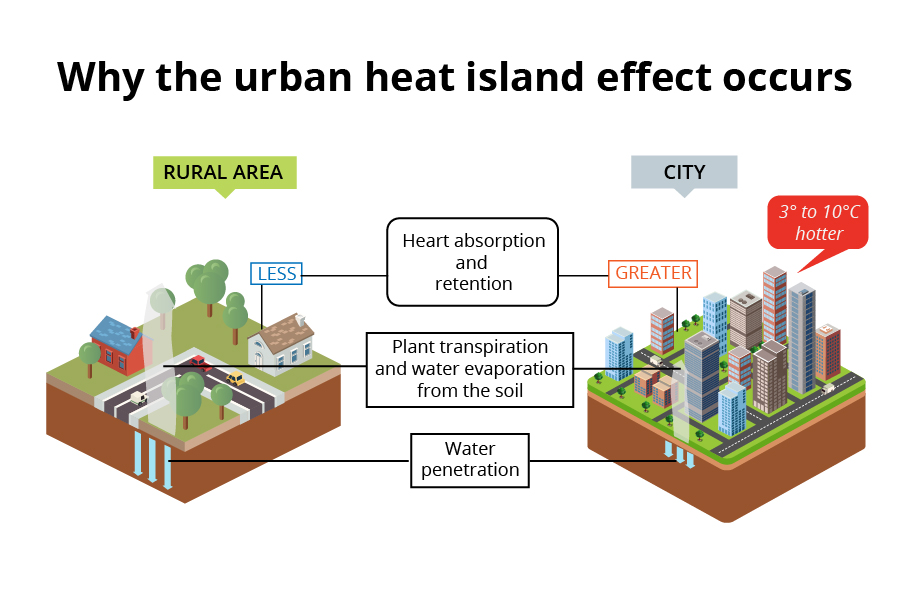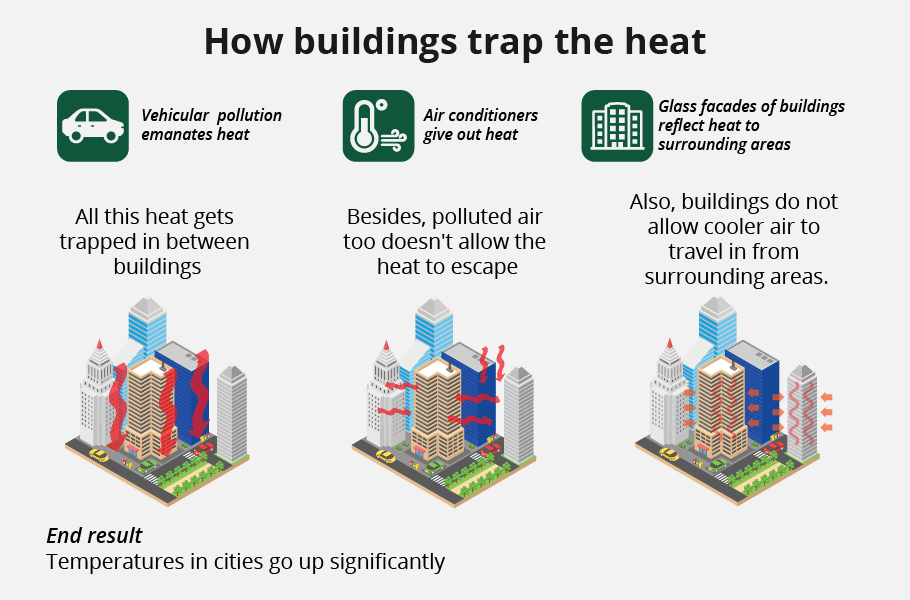
Heatwave effect can be cut by decongesting cities

At 43.1 degrees Celsius, Delhi recently experienced the hottest day in July in 9 years. Meanwhile, parts of Canada and US are caught in a heat dome effect, which has seen the temperature rising to 50 degrees Celsius mark and killing more than 800 people so far.
While it is difficult to draw any parallels between the two events happening in two different places separated by geographies and varied climatic zones, scientists attribute both to what we loosely call climate change.
Impact of heat wave
Not just Delhi, but every part of India has suffered the direct or indirect consequences of extreme heatwave conditions, which have caused destruction and taken away lives. For records, heatwaves claimed over 6,000 lives in India from 2000 to 2018. However, the reported numbers are just 10% of the actual deaths, experts say. This is mainly because of a faulty reporting system that counts a death as a heatstroke death only if certified by a doctor as having been caused by direct exposure to rays of the sun.
The effect of extreme heat on agriculture is profound. Firstly, it results in excessive and fast evaporation of water, causing water shortage. Secondly, it affects yield due to uncontrolled pest and disease attacks on crops and reduced labour output due to excessive heat. As per one Lancer report of 2017, India suffered a loss of 75 billion hours of labour because of temperature spike which makes ‘sustained work increasingly difficult.’
Heat island effect
While climate change and global warming affect all – urban dwellers and village folks – it is the city residents who feel the heat more because of the heat-island effect. Compared to rural areas, cities report, on average, 3 to 12°C higher temperatures. Our urban settings, comprising tall and compact buildings, expose residents to extreme heat caused due to microclimatic changes. The problem is more severe in developing countries where urban municipal administrations are ill-equipped to handle the resultant effects.

Vehicles, industries, air conditioners etc let out pollutants in the air. They also emanate heat, which often gets trapped due to air pollution and increases the micro temperature. Humid conditions, currently experienced in Delhi, due to some rain (though not enough) aggravate the heating effect.
Experts suggest the situation will only get worse if we do not adopt green building plans, which is not possible unless we decongest our cities. They warn that temperatures in South Asia will exceed the limits of human survival by the end of this century.
Inadequate or poorly designed houses clubbed with lack of access to basic amenities like drinking water or electricity will only make this heating effect more unbearable for city dwellers.
Need for heat action plan
India, like most countries in the world, is ill-equipped to handle heatwaves and its effects on society. France set an example some 17 years back when it prepared a comprehensive ‘heatwave plan’. It was a knee-jerk reaction to an extreme heatwave in that country in 2003 which killed over 14,000 people. The European country set up an alert system, conducted public information campaigns and paid more attention to the health of the most vulnerable like the elderly. France’s model worked because in 2006 it recorded about 4,000 fewer deaths due to heatwave.
In 2019, the Union Ministry of Environment and Forests (MoEF) in India launched the India Cooling Action Plan (ICAP) to cut pollution and “improve access to cooling for the Indian population”. The 20-year plan, according to State of India’s Environment Report -2020, is a roadmap to address cooling requirements in building, cold chain, transport and refrigeration sectors.
ICAP aims to target the most vulnerable population by cutting their exposure to heat wave by way of using energy efficiency tools while reducing greenhouse gas emissions.
Also read: Scientists write to President listing out ecological threats of Lakshadweep plan
The State of India’s Environment Report -2020 suggests that ICAP has not set strong, long-term benchmarks of its own. Almost all ministries have set up climate change mitigation targets and ICAP offers nothing to support these efforts or go a step ahead of them. For example, ICAP recommends an independent ‘heat action plan’ for every city with a population of 25 lakh and above. However, only 12 cities in India would fall in this category. What about the rest of India where urbanisation has taken myriad proportions?
Bhira village, nestled in the green Sahyadri mountains of Raigad district of Maharashtra, experienced 47 degrees Celsius temperature in March 2017, which was unusual given its geography. Churu in Rajasthan burned at 51°C in 2019. While Churu has a population of 1.2 lakh, Bhira is a small hamlet with a few houses. As per ICAP recommendations, the government cannot have a ‘heat action plan’ for these and many more small towns like them.
The local administration in Ahmedabad did prepare an action plan after heat wave killed about 1,500 people in this Gujarat city in 2013. An early warning system was the highlight of the plan. Since then several cities have developed their own heat action plans, but they have been mostly limited to asking people to stay indoors during peak summer hours and hospital preparedness.

How to reduce heating in cities?
The growing use of power-guzzling air conditioners (ACs) and closely packed tall buildings made of concrete along with air pollution mainly cause our cities to heat up.
Even planting trees, which is considered the one-stop solution to all environmental challenges, has failed to cut down the micro-heat effect in Indian cities. For example, Pune has substantially improved its green cover over the last 20 years and is considered one of the greenest cities in India. However, it has also added a lot of concrete in the form of roads and buildings, which has made summers unbearable in the city. Nobody used air coolers in Pune city 10 years back, but now every apartment needs one during April-May. The situation on the outskirts of Pune city is much better with fewer number of buildings, which allows the wind to circulate and give a cooling effect.

ACs give out a lot of heat. Besides, they consume a lot of electricity. The world is consuming over 2,000 terawatt-hours (TWh) of electricity every year, which is two-and-a-half times the total electricity used in all of Africa, says The State of India’s Environment Report -2020. We know most of the electricity today is made by burning fossil fuels, which directly contribute to greenhouse gas emissions.
In India, the sale of ACs is rising exponentially. The sale rose by almost 10 per cent in 2019, which experienced the worst summer in a decade. While renewable energy (RE) sources like solar and wind are gaining traction, they would prove grossly inadequate in meeting our population’s growing demand for cool air.
AC generates a lot of heat which is released into non-air conditioned spaces. As per one study, ambient temperatures can rise by 1-2°C due to the use of ACs in cities.
The use of ACs can be minimised by urban infrastructure planners, who can start y creating more airy cities and adopting green building plans, which use less of glass and concrete and more of local natural materials with good ventilation options.


